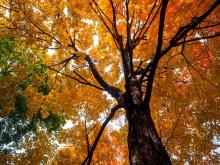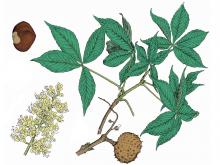Trees, Shrubs and Woody Vines
Media

Species Types
Scientific Name
Parthenocissus vitacea (syn. P. inserta)
Description
Woodbine is a climbing woody vine that usually sprawls over bushes and rocks. Its leaves have five coarsely toothed leaflets. Unlike the closely related Virginia creeper, its tendrils generally lack sucker disks. It is rarely found in Missouri.
Media

Species Types
Scientific Name
Cissus trifoliata (syn. C. incisa)
Description
Marine vine is a climbing or trailing woody vine to 30 feet high, climbing by tendrils. Uncommon in Missouri, it is found only in our far southwestern counties.
Media

Species Types
Scientific Name
Fraxinus spp.
Description
Missouri has six species of ashes that you might find in natural settings. They have been very popular as shade trees, and their wood is famously useful. Ash trees of all the species in North America are currently being killed by the invasive, nonnative emerald ash borer.
Media

Species Types
Scientific Name
Acer spp.
Description
Missouri has five species of maples that are either native or naturalized, plus several that are known only in cultivation. Maples are important members of native ecosystems. They also provide stunning fall color, welcome shade in summer, commercially important lumber, and sap for syrup.
Media

Species Types
Scientific Name
Zanthoxylum americanum
Description
Common prickly ash is a thicket-forming shrub or small tree. Its compound leaves resemble of those of ash trees, but it’s in a different family. Pairs of stout, curved prickles occur at each node. Scattered statewide, but less common in the Ozarks.
Media

Species Types
Scientific Name
Rubus occidentalis
Description
Black raspberries resemble blackberries, but when ripe, the fruits fall away as a caplike unit from the receptacle. Leaflets appear white underneath. The canes are whitish-coated when young; they arch down and take root at the tips. Native and scattered statewide.
Media

Species Types
Scientific Name
Aesculus pavia
Description
Red buckeye and Ohio buckeye are both found in Missouri. You can distinguish red buckeye by its having usually 5 leaflets (not 7), its red (not greenish-yellow) flowers, and the absence of any spines on its fruit hulls. Although both buckeyes are cultivated statewide, red buckeye grows in the wild only in our southeastern counties.
Media

Species Types
Scientific Name
Aesculus glabra
Description
Ohio buckeye is one of the first trees to leaf out in spring, and its palmately compound leaves make it look somewhat coarse textured. But most of all, buckeyes are known for buckeyes! People often carry these shiny brown seeds in their pockets for luck.
See Also
About Trees, Shrubs and Woody Vines in Missouri
There are no sharp dividing lines between trees, shrubs, and woody vines, or even between woody and nonwoody plants. “Wood” is a type of tissue made of cellulose and lignin that many plants develop as they mature — whether they are “woody” or not. Trees are woody plants over 13 feet tall with a single trunk. Shrubs are less than 13 feet tall, with multiple stems. Vines require support or else sprawl over the ground.





















